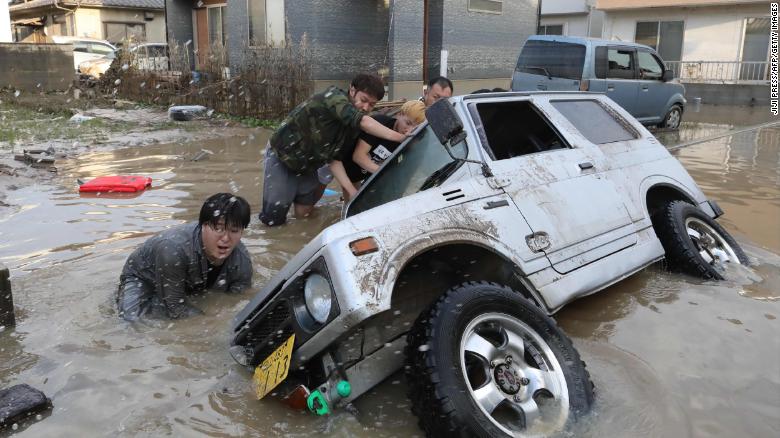Rescuers race to find survivors after Japan floods Death toll rises to 110 as officials warn of more landslides
The death toll from Japan’s worst flooding disaster in 35 years rose to more than 110 on Monday, with dozens still missing.
Record rainfall deluged central and southwestern Japan last week, causing widespread flooding, landslides, burst riverbanks and collapsed buildings.

While the rain eased off in some areas on Monday, swathes of Japan remained underwater and flood warnings were still in effect in the worst hit areas, including Okayama Prefecture.
Officials also warned of sudden showers, thunderstorms and the danger of more landslides in areas where steep mountainsides were already saturated from last week’s deluge.
On Monday morning Shinzo Abe, the prime minister, cancelled a trip scheduled to start Wednesday to Belgium, France, Saudi Arabia and Egypt in order to focus on the disaster.
Mr Abe also boosted the number of nationwide rescue workers assisting with the crisis to 73,000 as part of an emergency effort he earlier called a “race against time”.
Several million people across 19 prefectures were advised to leave their homes at various points over the weekend, with tens of thousands still reportedly seeking refuge in evacuation centres.
The number of casualties was expected to rise further this week as rescue operations continue, with 61 people still missing and many others thought to be stranded in their homes due to flooding or damaged infrastructure.
In some areas, the floodwaters began to recede on Monday, revealing the full extent of the devastation, with residents faced with cleaning up thick coats of brown mud, collapsed homes and overturned cars.
“I’ve never experienced anything like this is my life, and I’ve lived for more than 70 years,” said Hitoko Asano, 71, while cleaning her home in the badly-hit Mabi district of Kurashiki city in Okayama Prefecture.
“The washing machine, refrigerator, microwave, toaster, PC – they’re all destroyed.”
Another area devastated by the rains was Hiroshima Prefecture, where 170 patients and staff from one hospital were evacuated via helicopters and rafts through flooded streets in.
“I’m most grateful to the rescuers,” Shigeyuki Asano, a 79-year-old patient who was rescued after a night without electricity or water, told Reuters. “I feel so relieved that I am now liberated from such a bad-smelling, dark place.”
Hundreds of thousands of households were also without water supplies on Monday, while 11,200 homes had no electricity, according to power companies.
Yumeko Matsui, 23, a nursery school worker whose home in Mihara city, Hiroshima Prefecture, has been without water since Saturday, said: “We cannot take baths, the toilet doesn’t work and our food stockpile is running low.
“Bottled water and bottled tea are all gone from convenience stores and other shops.”
The deluge also hit regional industry operations, with Mazda Motor Corp, the carmakers, forced to close its head office in Hiroshima on Monday, while Panasonic, the electronics maker, suspended operations at one plant due to flooding.
It is the worst flooding disaster to hit Japan since July 1983, when 117 people were killed in heavy rains across several prefectures including Shimane in western Japan.
Ahead of last week’s deluge, the Japan Meteorological Agency issued Emergency Warnings to a number of prefectures, before 93 locations subsequently set new rainfall records within 72 hours, according to media reports.
The unusually intense rainfall was attributed to the remnants of a typhoon feeding into a seasonal rainy front, a situation exacerbated by humid warm air pouring in from the Pacific.
A similar weather pattern triggered heavy flooding in the same southwestern region of Japan a year ago, which also killed dozens and caused extensive damage.
source-NHK/telegraph
